Goodbye Reading Glasses!
Min’s Multifocal LASIK for Presbyopia
Just Like Multifocal Contact Lenses That Fit My Eyes- What is presbyopia?
- Principles of Min’s PresbyLasik for presbyopia
- Results for Min’s PresbyLasik
What is presbyopia?
Presbyopia is an age-related process, which develops a reduced refractive power of crystalline lens. When people develop presbyopia, they find they need reading glasses for near vision tasks such as reading. According to recent studies, as people age, human crystalline lens grows as an onion grows and the gap between ciliary muscles and the equator of the lens becomes narrowed. This gradual thickening of the lens leads to loss of flexibility of the lens and eventually causes presbyopia.

Symptoms of Presbyopia
- + Usually occurs at around of age 40. May occur at a younger age if hyperopic eyes.
- + Difficult to do near vision tasks (about 25~30 cm).
- + Alternating the point of focus from a distant object to a near object gets delayed.
- + May develop headache when reading books due to eyestrain.
- + Blurry vision and discomfort.
- + Gets worse when dark around.
History of development of Min’s PresbyLasik for Presbyopia by Dr. Byung Moo Min
As people do more near vision tasks such as using smart phones or tablet PCs, their eyes get tired easily. This causes presbyopia sometimes at a younger age. This also cause problems when doing everyday tasks such as reading cell phone texts, business cards, and documents. Multifocal LASIK for Presbyopia helps many middle-aged people to do near vision tasks without reading glasses.
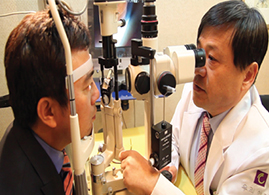
Development History
Did you know that Korean doctors have the best LASIK techniques in the world? Since presbyopia surgery was introduced to Korea in 1997, many procedures from abroad were introduced and performed. However, these procedures could not bring satisfactory results due to vision regression after surgery. Dr. Byung Moo Min started studies in 2005 in collaboration with Ronald A. Schachar, M.D., Ph.D., an American ophthalmologist and physicist who proposed a novel theory of accommodation and presbyopia and invented the accommodating IOL. The studies were finished in 2007 and proved with many years of clinical trials.
Min’s PresbyLasik
for Presbyopia (Min’s Invision)
Byung Moo Min, M.D. & Ph.D.
(Daejeon, Republic of Korea)
Presbyopia Etiology
Research
Ronald A. Schachar, Ph.D. & M.D.
(San Diego, United States)
To summarize the concept of the studies, it is to find the ways not to halt the regression of corneal topography but to pause at an ideal stage of the corneal regression. With many years of surgical experience of Korean ophthalmologists in conjunction with Dr. Schachar’s theory of presbyopia and the laser ablation technique, the studies were completed with development of customized surgical procedures for high myopia, medium myopia, low myopia, emmetropia, hyperopia, myopic astigmatism, hyperopic astigmatism, and intraocular lens implanted eyes.

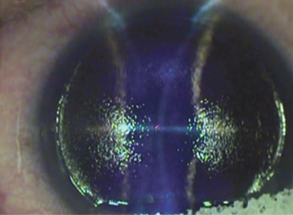
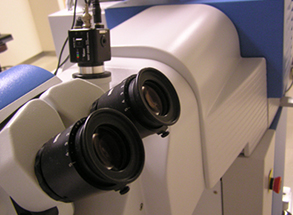
Excellence of Min’s PresbyLasik for Presbyopia
Allows everyday life without reading glasses via simultaneous far and near distance vision correction. Min’s Presby Lasik for presbyopia was developed in consideration of corneal regression.
Customized for different eye shapes.
Enables simultaneous far and near distance vision correction after cataract surgery. Min’s PresbyLasik for presbyopia also enables stable far and near distance vision correction via LASIK for people older than 30 and allows everyday life without reading glasses by preventing presbyopia.
Reduce eyestrain when doing near vision tasks by increased accommodation of the lens than LASIK.
A vision correction surgery just as multifocal contact lenses that fit my eyes. Min’s PresbyLasik for presbyopia corrects presbyopia in middle-aged people as LASIK, but also corrects near distance vision.
Corrects far and near distance vision by customized procedures for individual eye shapes for early presbyopia. Min’s PresbyLasik for presbyopia enables the minimum corneal ablation using the world’s smallest 0.44mm oval type laser beam, which makes a smooth surface.
Also, depending on types of presbyopia (hyperopic, myopic, emmetropic) and degrees of astigmatism, we find customized procedures for each individual in consideration of corneal regression after surgery to maintain stable vision. The laser beam is elaborately applied multiple times where needed.
Features of LASER for Min’s PresbyLasik for Presbyopia
+ Fractal algorithm (Reductive method)+ Simultaneous use of more than 2 laser spots (World patent, 1997)
+ Using the world’s best laser beam, minimized depth of ablation per 1 spot: 0.20 microns
+ Ablation method: Random projection
+ Optimal laser beam speed: 600 Hz (300 Hz x 2 spots)
+ Quasi-Gaussian beam
Possible surgeries using LASER for Min’s PresbyLasik for Presbyopia
- 1. Presbyopia corrective surgery for people at the age of 40~70
- 2. Near and far distance vision correction for patients who received cataract surgery
- 3. People at the age of 30~40 who want to receive LASIK/LASEK
- 4. People older than 30 who want to receive LASIK in prevention of presbyopia
- 5. People who do near vision tasks (computer, smartphones) a lot and want to receive LASIK
Difference between the existing presbyopia correction surgeries
- Min’s PresbyLasik for presbyopia enables vision correction without side effects such as halo or glare through the minimum corneal ablation. LASIK in middle-aged and late middle-aged people can cause failing near vision after surgery due to presbyopia. Min’s PresbyLasik for presbyopia allows everyday life without reading glasses.
- For presbyopic eyes, the stable simultaneous far and near distance vision correction in consideration of regression enables everyday life without reading glasses.
- For patients who received cataract surgery, simultaneous far and near distance vision correction is possible. Re-correction for people who have side effects due to other presbyopia correction surgery or who currently use reading glasses is also possible.
Advantages and Features
The Best Possible Vision – Gain near distance vision while maintaing far distance vision.
The Minimum Corneal Ablation and Smooth Surface – Achieved the minimum corneal ablation using the world’s smallest 0.44mm oval type laser beam, which yields a smooth surface.
Near Vision
Far Vision
- Far
- Near
The central cornea is
corrected for far
distance vision
The peripheral
cornea is corrected for
near distance vision
Principles of Min’s PresbyLasik for presbyopia
Min’s PresbyLasik for presbyopia enables to see far distance through the center of the cornea, and to see near distance through the periphery of the cornea using the world’s smallest 0.44 mm laser beam, which minimize the corneal ablation and yields smooth surface with improved safety. Re-correction is also possible to improve and compensate for less satisfactory results.
- Age: 40~70
- Ablation in the center of
the cornea for far distance
vision correction - Ablation in the
periphery of the cornea
(3~6 mm) for near
distance vision correction
- Age: 20~30
- The central corneal
ablation of 6~7mm in
diameter for far
distance vision correction
| Principles | Descriptions | |
| LASIK |  |
LASIK is a monofocal vision correction surgery which ablates the center of the cornea (6.0 mm) using a 0.6 ~ 1.0 mm laser beam. |
| Min’s PresbyLasik |
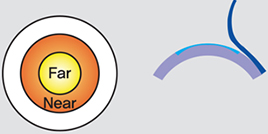 |
Min’s PresbyLasik uses the world’s smallest 0.44 mm laser beam to correct the center of the cornea (3.0 mm) for far distance vision, and to correct the periphery of the cornea (3.0 ~ 6.0 mm) for intermediate and near distance. |
Surgical Method
The Most Effective and Safest MethodPresbyopia Center in Woorieye Clinic’s Special Know-How (chairman: Byung Moo Min, M.D., Ph.D.)
The principle of Min’s PresbyLasik for presbyopia is to see far distance through the center of the cornea,
and to see near distance through the periphery of the cornea.
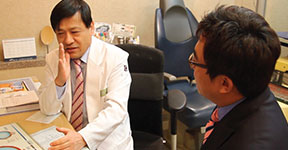 The customized procedures correct the center of the cornea for myopic patients; correct the periphery of the cornea for emmetropic and hyperopic patients; and correct the whole cornea if patients have astigmatism. Also depending on the thickness and the state of the cornea, LASIK can be performed to preserve the corneal epithelium or LASEK can be performed to remove the corneal epithelium.
The customized procedures correct the center of the cornea for myopic patients; correct the periphery of the cornea for emmetropic and hyperopic patients; and correct the whole cornea if patients have astigmatism. Also depending on the thickness and the state of the cornea, LASIK can be performed to preserve the corneal epithelium or LASEK can be performed to remove the corneal epithelium.
One of the great advantages of the multifocal LASIK for presbyopia is that the world’s smallest laser beam is used (0.44mm). This smallest laser beam minimizes the corneal ablation and yields smooth surface with improved safety. Re-correction is also possible to improve and compensate for less satisfactory results.
Central Cornea
Myopia: Central and Peripheral Corneal Correction
Hyperopia, Emmetropia: Peripheral Corneal Correction
Astigmatism: Whole Corneal Correction
Provides a stronger vision correction via multifocal ablation, which yields spherical and aspherical corneal surface for the center and the periphery of the cornea to have different focusing distance.
Multifocal Corneal Day – Outdoor Activity
Increased Emmetropic Effect
Pupils Contracting
Better Far Distance Vision
Night – Indoor Activity
Increased Myopic Effect
Pupils Dilating
Better Near Distance Vision
Surgical Procedures Depending on the State of the Cornea
- Make a flap using keratome
- Correct patient's myopia / hyperopia
/ astigmatism first using LASER - Peripheral corneal ablation for near distance vision
- Central corneal ablation for near distance vision correction
- Close the flap and finish
- Remove corneal epithelium
- Correct patient’s myopia / hyperopia / astigmatism first using LASER
- Peripheral corneal ablation for near distance vision
- Central corneal ablation for near distance vision correction
- Fit T-lens and finish
Results for Min’s PresbyLasik
Results for patients at 20~43 of age who do a lot of near vision tasks
1. Good results for near distance and far distance vision: 0.9 ~ 1.0
2. Reduced eyestrain when doing near vision tasks due to better refractivity
For patients who had cataract surgeries, near distance vision improved from 0.1 ~ 0.2 to 0.65 ~ 0.8 without reading glasses after they received Min’s PresbyLasik. Patient satisfaction is also improved.
Results for Min’s PresbyLasik for presbyopia
Hyperopic or Emmetropic Presbyopia
May experience blurry vision when dark around (day or night) or glare in the night after surgery, but soon these symptoms will go away as time passes and the corneal refractivity gets stabilized. Patients should give extra attention to dry eye syndrome.
Low Myopia
Will experience better far distance vision, and the near distance vision will get improved after 1 month. Patients should give extra attention to dry eye syndrome. Patients will have satisfactory far and near distance vision as time passes and the corneal refractivity gets stabilized.
Medium or High Myopia
Require longer time to have better far and near distance vision than low myopic patients. Recovery period is proportional to the degrees of myopia. Patients should give extra attention to dry eye syndrome. Patients will have satisfactory far distance vision after 2 weeks and near distance vision after 1 month.
It is a very safe procedure for other side effects are on the level of LASIK procedures. Most of patients will have the expected results after surgery, but there may be individual differences after recovery from the surgery. It is possible for a person to have undercorrection or overcorrection. For most cases, it will be resolved by medications and re-correction is also possible. It is common for these subjective symptoms to disappear as time passes.
 ENG
ENG CHN
CHN RUS
RUS
